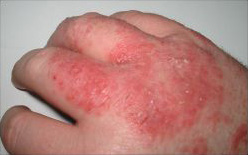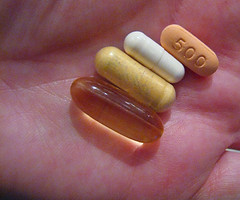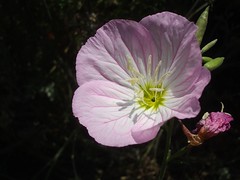
Evening primrose oil seems to pop up in a lot of my products. I like the romantic and whimsical sound of it. Just imagine, “evening primrose oil” — it sounds like some kind of fragrant beauty additive that makes skin feel petal-soft, doesn’t it? But it’s almost never the main ingredient (aside from evening primrose supplements and straight oil). It rarely stands on its own two feet as an independently appreciated addition to beauty products. So what does it do that warrants having supplements and why is it included in beauty products?
Well, in fact, there are a couple claims:
1) It’s rich in antioxidants
2) It will have a mild, beneficial effect for people with atopic dermatitis.
3) It will improve skin, and help with PMS and menopause.
But let’s look at the facts, shall we?
It has antioxidant powers

In a study of unconventional oils — including Viper’s bugloss, sea buckthorn, and quince oil — evening primrose oil was found to have the highest level of free-radical scavenging antioxidants. That’s because it has a high phenolic acid content. The study found that evening primrose oil had a 91.23% antioxidant activity in terms of scavenging DPPH free radicals (Journal of the American Chemists’ Society).
Another study found that evening primrose seed extract worked more effectively than commercially extracted filter cake and equally as effectively at preventing oxidation in water than butylated hydroxytoluene (BHT). BHT is currently used in cosmetics and has undergone scrutiny in the public (but I’ll save that for another post). Evening Primrose was as effective as BHT only when used in higher concentrations, and the two had a synergistic effect when paired (Journal of Agricultural and Food Chemistry).
Another study that compared it to the likes of grape seed oil and green tea extract found it to be highly effective as an antioxidant and free radical scavenger (Industrial Crops and Products). But there haven’t been as many studies on evening primrose oil to test its efficacy on human skin, which is important before judging its efficacy as compared to these ingredients in beauty products.
What’s the research on how it helps skin disorders?

There’s some evidence that evening primrose oil in pill form can help to treat atopic dermatitis. Emphasis on some. Results in studies tend to vary quite a bit. One analysis of 11 studies found there wasn’t enough evidence to support evening primrose oil as a treatment for atopic dermatitis (Health Technology Assessment). Another meta-analysis found that evening primrose had a moderate effect in treating atopic dermatitis — but this analysis also included industry studies (Current Pharmaceutical Biotechnology). Researchers are unsettled on whether evening primrose oil will work to treat atopic dermatitis — some studies have found it to be very effective, while others have seen absolutely no effect. More research needs to be done to decide.
However, there have been studies to look at evening primrose oil’s general effects on skin that have been more positive. One study shows that when taken in pull form it strengthens skin barrier function (International Journal of Cosmetic Science). Another found similar effects when applied topically — but only with a water-in-oil emulsion, not with an amphiphilic emulsion (Arzneimittel-Forschung). Still, these studies are rather limited compared to those testing the efficacy of other ingredients.
What’s the research on how it helps PMS and menopause?

If the results for atopic dermatitis treatment are tenuous at best, those for PMS and menopause are even less convincing. There have been a handful of studies with mixed results on the matter. On analysis of several trials said that evening primrose oil was no more effective at treating symptoms of both than a placebo (Breast). Another analysis showed the same result — no benefits from taking evening primrose oil to women suffering from PMS (American Journal of Obstetrics and Gynecology). And a study of menopausal flushing found that evening primrose oil offered no relief (Biomedical Journals).
Bottom Line

Evening primrose oil likely pops up in a lot of products for a few reasons. It’s antioxidant properties help prevent oxidation in products and likely benefit the skin. Studies haven’t necessarily supported the claim that it can help atopic dermatitis or PMS and menopause symptoms when taken as a pill, but the only side effects they’ve found have been gastrointestinal upset and headaches. Topically applied, the studies are limited, but show a positive effect in improving skin barrier function. Essentially, evening primrose oil is not likely to hurt you so long as it doesn’t irritate your skin or cause issues with other medications you’re taking. If you take it as a supplement you should always consult your doctor as, like anything, it can interact with other medications or supplements you’re taking. Overall, it could be beneficial, but it’s efficacy has yet to be proven.

